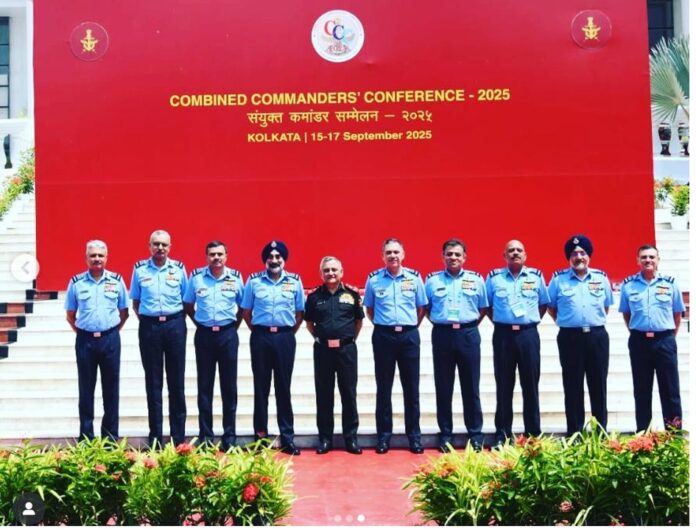Lt Col Narendra Tripathi (r)
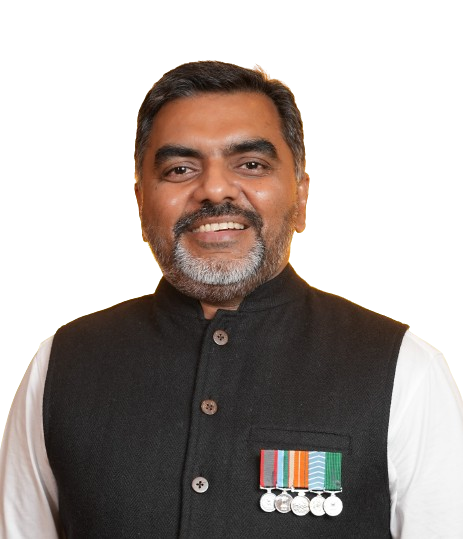
The Indian defence establishment is undergoing a historic transformation with the proposed theaterisation of its forces, a structural reform aimed at integrating the Army, Navy, and Air Force under unified theatre commands for cohesive joint operations. Theaterisation promises efficiency, synergy, and joint warfighting capability. Still, it also brings formidable challenges: integrating diverse command structures, ensuring system interoperability, accelerating decision-making in contested environments, and sustaining logistics across vast geographical theatres.
Against this backdrop, the Combined Commanders’ Conference (CCC-2025) in Kolkata has emerged as a landmark step in India’s reform journey. The conference produced decisions that will accelerate jointness, integration, and capability development across the services, holding profound implications for the Indian Air Force (IAF). Among the highlights was the creation of three new Joint Military Stations, signalling concrete progress towards integrated force structures capable of delivering unified combat power across domains. Equally significant was the decision to merge the education branches of the three services into a Tri-Services Education Corps, institutionalising joint training and human resource development.
The CCC also placed strong emphasis on indigenous capability-building, faster acquisition, and emerging domains such as cyber and space. The release of the Joint Military Space Doctrine underscored the strategic significance of space in future conflicts. In this arena, China’s rapid advances in counter-space capabilities, including jamming and anti-satellite weapons, present clear risks. For the IAF, this doctrine reinforces the need to deepen its role in space-enabled ISR, communication resilience, and counter-space preparedness as part of its contribution to theatre commands.
From the nation’s political and military leadership, there is an urgency of jointness, atmanirbharta, and a technology-led approach to modern warfare. For the IAF, this translates into harnessing artificial intelligence (AI), autonomy, and innovation to preserve air dominance while ensuring seamless integration with land and maritime operations.
Yet, theaterisation is not without friction. From the IAF’s perspective, critical concerns remain. Chief among them are the dilution of scarce air assets if divided among multiple theatres, the potential subordination of air power to ground or maritime priorities, institutional disruption from dismantling long-standing command structures, operational delays from new decision-making chains, and the financial burden of duplicating infrastructure. Additionally, the IAF has cautioned that a “one-size-fits-all” model, borrowed from foreign examples, may not suit India’s unique threat environment.
AI & IAF
In this complex environment, Artificial Intelligence emerges as a strategic enabler, offering practical solutions to many of these challenges. Predictive maintenance powered by machine learning can raise aircraft availability, offsetting concerns over asset dilution. AI-enabled decision support systems can ensure that doctrinal principles of air power remain embedded in joint planning, safeguarding autonomy. Autonomous navigation, swarming, and edge AI can support distributed operations across multiple theatres, maintaining tempo even in GPS-denied or communication-contested conditions. Meanwhile, Generative AI (Gen AI) platforms such as Samvaad AI, being developed under the IDEX initiative for the Indian Navy, can automate mission briefs, intelligence summaries, and decision-support material, reducing staff workload and ensuring faster, more accurate joint decision-making.
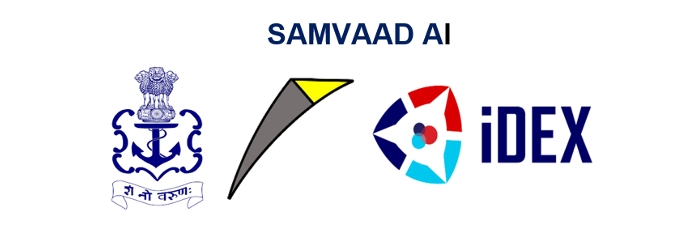
for Indian Navy
AI also offers solutions to institutional and financial hurdles. AI transition simulators can model alternative command structures and test interoperability before implementation, helping to manage resistance. Joint AI platforms and wargaming tools provide transparent, data-driven insights to reduce inter-service rivalry. On the financial front, AI-driven cost optimisation and predictive logistics can streamline expenditure by reducing duplication and sustaining efficiency across dispersed bases.
AI is not a replacement for pilots or commanders but a force multiplier. It amplifies reach, speeds up decision-making, and preserves doctrinal independence while enabling joint integration. By adopting AI strategically, the IAF can transform theaterisation from a risk into an opportunity, emerging not only as a central pillar of India’s integrated defence architecture but also as a global leader in AI-enabled air power, prepared to meet the challenges of future warfare.
Why Theaterisation Demands an AI-Enabled Air Force
Under theaterisation, the IAF’s role will extend beyond independent air campaigns to providing theatre-wide ISR, logistics, and joint decision-making support. This expansion of responsibilities introduces multiple challenges:
• Information Overload: Unified commands will generate massive amounts of multi-service data, impractical to process manually.
• Joint Decision-Making: Air commanders will need faster intelligence synthesis and rapid dissemination of mission-ready insights.
• Distributed Operations: Air assets spread across geographically diverse theatres will require autonomy, swarming, and predictive logistics to maintain operational tempo.
• Resource Optimisation: Budgetary constraints necessitate maximising asset availability and lifecycle value.
AI directly addresses these challenges by automating data-heavy processes, accelerating decision cycles, and optimising resource use, making it indispensable for theaterised operations.
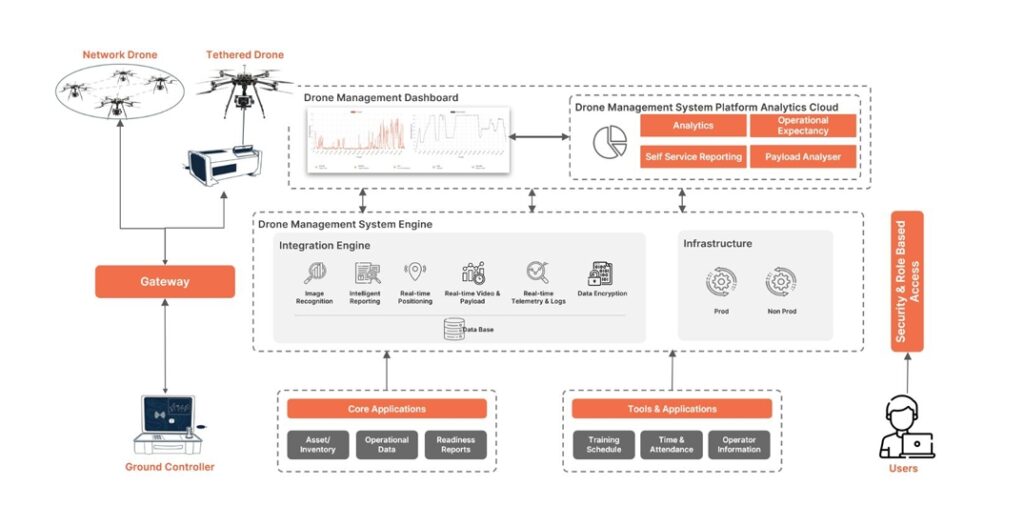
www.axldrone.com
IAF Challenges of Theaterisation
The Indian Air Force (IAF) faces multiple challenges in the context of theaterisation, spanning operational, institutional, and financial domains. A key concern is asset allocation and doctrinal autonomy, as limited fighter and transport aircraft risk being spread thin across multiple theatres, reducing overall combat effectiveness. There is also apprehension that air power may become subordinate to land or naval priorities, undermining the independent application of air doctrine. On the structural and institutional front, dismantling decades-old service-specific commands poses a disruptive challenge. It is likely to face resistance, while sharing resources between the services could complicate integration. At the operational and strategic level, new theatre structures may create longer decision-making chains, causing delays in response, and foreign models of theaterisation may not be suitable for India’s unique threat environment. Finally, there are financial and resource concerns, as building infrastructure for multiple theatres would place a heavy burden on the defence budget, while assigning separate air assets to each theatre risks inefficient duplication of resources.
AI as a Strategic Enabler
In addressing the challenge of asset allocation and doctrinal autonomy under theaterisation, AI offers robust solutions to preserve the effectiveness and independence of air power. Predictive maintenance and fleet readiness AI can anticipate failures, optimise maintenance cycles, and increase aircraft availability, ensuring that combat power is sustained even when assets are distributed across multiple theatres. AI-driven asset optimisation models can recommend fleet deployment based on real-time threat assessments and logistics, enhancing combat effectiveness while avoiding duplication of scarce resources. At the doctrinal level, AI-enabled decision support systems provide independent, data-backed recommendations for air campaigns, ensuring that the principles of air power remain protected within joint decision-making structures. Furthermore, Generative AI knowledge engines, such as ZM-Tathya, can embed IAF’s doctrinal frameworks directly into joint planning processes, guaranteeing that the unique logic of air power continues to guide integrated operations. Together, these AI-enabled tools safeguard the IAF’s autonomy while enabling efficient and effective participation in theaterised commands.
To overcome the structural and institutional hurdles of theaterisation, AI can play a pivotal role in easing the transition and fostering collaboration among the services. AI transition simulators can model alternative command structures, assess their efficiency, and forecast interoperability outcomes before actual implementation, thereby reducing uncertainty and resistance. Generative AI tools for change management can further streamline the process by automating updates to SOPs, doctrines, and training documentation, ensuring smoother adaptation to new structures. At the operational level, joint AI platforms provide transparent, data-driven mission planning that helps minimise inter-service rivalry and competition for resources. Complementing this, AI-enabled wargaming allows the simulation of joint scenarios to demonstrate the practical benefits of integration, building confidence and trust among the services. Together, these AI-enabled solutions offer a structured approach to mitigating institutional resistance while strengthening the foundation for cohesive theatre commands.
When it comes to operational and strategic concerns, AI offers transformative tools to enhance responsiveness and adaptability within a theaterised structure. AI-enhanced command and control (C2) systems can automate sensor fusion, target prioritisation, and mission planning, dramatically accelerating the OODA loop and reducing decision-making delays. Supporting this, Generative AI assistants can create real-time reports and operational briefs, ease staff workload, and ensure commanders have accurate, timely information to act swiftly. To tailor theaterisation to India’s unique context, adaptive AI simulations can model scenarios for China, Pakistan, and the maritime fronts, avoiding the pitfalls of one-size-fits-all foreign models. Additionally, dynamic vulnerability modelling allows continuous refinement of command structures and strategies in response to evolving threats. Collectively, these AI capabilities strengthen operational agility, ensuring that the IAF and the wider armed forces remain prepared to meet the demands of complex, multi-domain environments.
Addressing the financial and resource strain of theaterisation, AI provides innovative, cost-effective solutions to maximise efficiency while minimising duplication. AI-driven cost optimisation tools can prioritise infrastructure projects and procurement decisions based on readiness-to-cost ratios, ensuring investments deliver maximum operational value. Predictive logistics AI further strengthens sustainment by optimising spares management, fuel usage, and maintenance cycles, thereby reducing long-term costs. To prevent inefficiencies, centralised AI resource management systems can dynamically allocate scarce air assets across different theatres in real time, ensuring resources are deployed where they are needed most.
Complementing this, the use of digital twins — virtual replicas of platforms and systems — enables realistic planning, simulation, and training without requiring the physical duplication of assets. Together, these capabilities ease financial pressures and optimise resource utilisation, making theaterisation more economically sustainable for the IAF and the broader armed forces.
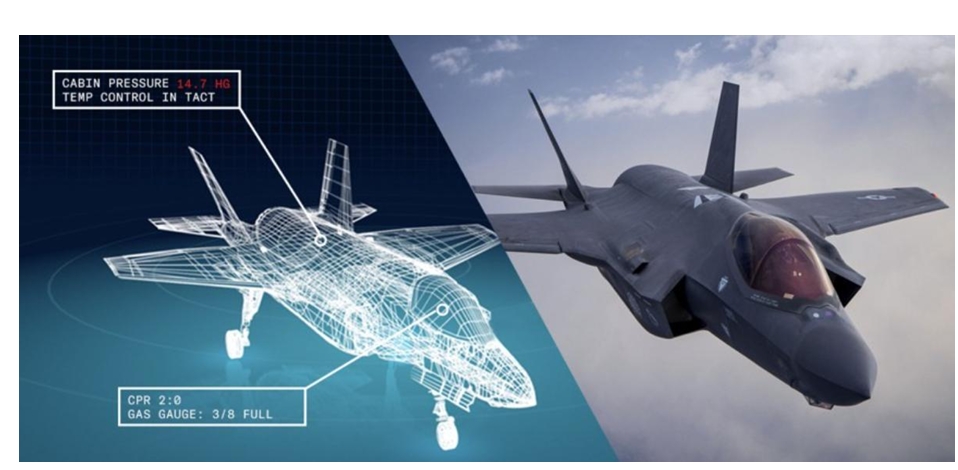
Dell Tech
Strategic AI Capability Clusters for a Theaterised IAF
To fully harness the potential of AI in the era of theaterisation, the IAF must focus on developing seven interrelated capability clusters that, together, provide a robust and future-ready framework. AI-assisted ISR and multi-sensor fusion will automate anomaly detection, integrate diverse sensor inputs, and deliver real-time target cueing for joint forces, greatly enhancing situational awareness. Predictive maintenance and logistics optimisation will improve fleet readiness by anticipating component failures and streamlining logistics pipelines.
In contested environments, autonomous navigation and adaptive flight control will enable operations without GPS, reducing pilot workload and improving survivability. Swarm and collaborative unmanned systems will expand the IAF’s reach through distributed ISR, deception tactics, saturation strategies, and cooperative payload delivery. At the same time, edge AI and resilient inference will ensure autonomy by processing data directly on aircraft and drones, maintaining effectiveness even in communication-denied zones. On the planning and decision-making front, Generative AI for knowledge management and decision support can automate the creation of mission documents, intelligence briefs, and operational insights while maintaining sovereignty and data security. Finally, responsible AI frameworks must be established to embed governance, red-teaming, auditability, and adherence to international humanitarian law, thereby ensuring trust, legitimacy, and ethical application of AI in combat. Together, these clusters form the cornerstone of an AI-enabled IAF capable of thriving in multi-domain, joint operational environments.
For AI to succeed in theaterisation, strong governance frameworks and skilled human capital are essential. Establishing dedicated AI governance boards will help ensure doctrinal consistency, operational safety, and compliance with legal and ethical standards. Alongside this, red-team testing must be institutionalised to rigorously stress-test AI systems against electronic warfare conditions and adversarial attacks, ensuring resilience in contested environments. Building a capable workforce is equally critical; this requires creating AI-specific career tracks, certifying operators and engineers, and fostering continuous learning through academic-industry partnerships. Finally, robust knowledge management systems, supported by Generative AI, should be developed to maintain repositories of datasets, experiment logs, and validated models, promoting transparency, institutional memory, and reusability. Together, these measures will provide the governance and human expertise needed to integrate AI effectively into theaterised operations.
Conclusion: AI as a Strategic Bridge in Theaterisation
Theaterisation presents both organisational and operational challenges, and for the IAF, the risks of diluted assets, doctrinal erosion, and financial strain are significant. Yet, AI provides transformative pathways to turn these risks into opportunities. Predictive maintenance and optimisation tools can preserve combat effectiveness, while AI-enabled decision support systems and Gen AI knowledge engines safeguard doctrinal autonomy. AI-enhanced command and control, supported by adaptive simulations, accelerates decision-making and tailors models to India’s unique operational needs. At the same time, cost-optimisation and resource-management tools help ease financial pressures and ensure the efficient use of limited resources. By adopting AI in a responsible, modular, and sovereign manner, the IAF can ensure that air power remains central to joint operations, enabling it not only to adapt but to lead in shaping the success of theaterisation. The CCC-2025 decisions mark real progress toward building an integrated, agile, and technologically advanced force. For the IAF, the way forward lies in leveraging its edge in ISR, space, and AI-driven decision support to anchor India’s theaterised joint force in an era of multi-domain threats and to emerge as a global leader in AI-enabled air power.
Lt Col Narendra Tripathi (r) is an alumnus of IIT Kanpur with research in Exoskeleton. He is also an SME and independent consultant in military technology.

